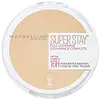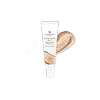Maybelline Super Stay Full Coverage Powder Foundation Versus Ever Bilena Plus Good Skin Day Serum Infused Skin Tint
What's inside
What's inside
 Key Ingredients
Key Ingredients

 Benefits
Benefits

 Concerns
Concerns

 Ingredients Side-by-side
Ingredients Side-by-side

Talc
AbrasiveMagnesium Stearate
Cosmetic ColorantPolymethyl Methacrylate
Synthetic Fluorphlogopite
Isononyl Isononanoate
EmollientNylon-12
Hydrogenated Polydecene
EmollientVinyl Dimethicone/Methicone Silsesquioxane Crosspolymer
Diphenyl Dimethicone/Vinyl Diphenyl Dimethicone/Silsesquioxane Crosspolymer
Aluminum Hydroxide
EmollientDimethicone
EmollientPerfluorooctyl Triethoxysilane
Ethylhexylglycerin
Skin ConditioningLauroyl Lysine
Skin ConditioningMethicone
EmollientHydrogenated Palm Oil
EmollientPalmitoyl Proline
Skin ConditioningGlycerin
HumectantHydrogen Dimethicone
Water
Skin ConditioningSodium Palmitoyl Sarcosinate
CleansingMagnesium Palmitoyl Glutamate
Skin ConditioningPalmitic Acid
EmollientPhenoxyethanol
PreservativeMoringa Oleifera Seed Extract
Skin ConditioningDisodium Phosphate
BufferingCitric Acid
BufferingTocopherol
AntioxidantCI 77891
Cosmetic ColorantMica
Cosmetic ColorantCI 77491
Cosmetic ColorantCI 77492
Cosmetic ColorantCI 77499
Cosmetic ColorantTalc, Magnesium Stearate, Polymethyl Methacrylate, Synthetic Fluorphlogopite, Isononyl Isononanoate, Nylon-12, Hydrogenated Polydecene, Vinyl Dimethicone/Methicone Silsesquioxane Crosspolymer, Diphenyl Dimethicone/Vinyl Diphenyl Dimethicone/Silsesquioxane Crosspolymer, Aluminum Hydroxide, Dimethicone, Perfluorooctyl Triethoxysilane, Ethylhexylglycerin, Lauroyl Lysine, Methicone, Hydrogenated Palm Oil, Palmitoyl Proline, Glycerin, Hydrogen Dimethicone, Water, Sodium Palmitoyl Sarcosinate, Magnesium Palmitoyl Glutamate, Palmitic Acid, Phenoxyethanol, Moringa Oleifera Seed Extract, Disodium Phosphate, Citric Acid, Tocopherol, CI 77891, Mica, CI 77491, CI 77492, CI 77499
Water
Skin ConditioningCyclopentasiloxane
EmollientGlycerin
HumectantIsononyl Isononanoate
EmollientDimethicone
EmollientGlycereth-26
HumectantSilica
AbrasivePEG-10 Dimethicone
Skin ConditioningCyclohexasiloxane
EmollientPolymethyl Methacrylate
Sodium Chloride
MaskingPhenyl Trimethicone
Skin ConditioningIsododecane
EmollientPhenoxyethanol
PreservativeTocopheryl Acetate
AntioxidantBiosaccharide Gum-1
HumectantDimethiconol
EmollientCaprylyl Glycol
EmollientParfum
MaskingDisteardimonium Hectorite
StabilisingDisodium EDTA
Bakuchiol
AntimicrobialPropylene Carbonate
SolventSodium Hyaluronate
HumectantCI 77891
Cosmetic ColorantIsopropyl Titanium Triisostearate
EmollientAlumina
AbrasiveCI 77491
Cosmetic ColorantCI 77492
Cosmetic ColorantCI 77499
Cosmetic ColorantWater, Cyclopentasiloxane, Glycerin, Isononyl Isononanoate, Dimethicone, Glycereth-26, Silica, PEG-10 Dimethicone, Cyclohexasiloxane, Polymethyl Methacrylate, Sodium Chloride, Phenyl Trimethicone, Isododecane, Phenoxyethanol, Tocopheryl Acetate, Biosaccharide Gum-1, Dimethiconol, Caprylyl Glycol, Parfum, Disteardimonium Hectorite, Disodium EDTA, Bakuchiol, Propylene Carbonate, Sodium Hyaluronate, CI 77891, Isopropyl Titanium Triisostearate, Alumina, CI 77491, CI 77492, CI 77499
 Reviews
Reviews

Ingredients Explained
These ingredients are found in both products.
Ingredients higher up in an ingredient list are typically present in a larger amount.
Ci 77491 is also hydrated iron III oxide. It's sole purpose is to give a red/pink hue to products.
Iron III oxides are classified as inorganic chemicals for coloring.
Synthetically created Ci 77491 is considered safer than those naturally found. This is because the synthetically created version may contain less impurities. Iron oxides are generally non-toxic and non-allergenic.
Learn more about CI 77491Ci 77492 is also hydrated iron III oxide. It's sole purpose is to give a yellow hue to products.
Iron III oxides are classified as inorganic chemicals for coloring.
Synthetically created Ci 77492 is considered safer than those naturally found. This is because the synthetically created version may contain less impurities. Iron oxides are generally non-toxic and non-allergenic.
Learn more about CI 77492Ci 77499 is also hydrated iron III oxide. It is created from mixing red and black iron oxides. This helps give shades of darkness to a product.
Iron III oxides are classified as inorganic chemicals for coloring.
Ci 77891 is a white pigment from Titanium dioxide. It is naturally found in minerals such as rutile and ilmenite.
It's main function is to add a white color to cosmetics. It can also be mixed with other colors to create different shades.
Ci 77891 is commonly found in sunscreens due to its ability to block UV rays.
Learn more about CI 77891Dimethicone is a type of synthetic silicone created from natural materials such as quartz.
What it does:
Dimethicone comes in different viscosities:
Depending on the viscosity, dimethicone has different properties.
Ingredients lists don't always show which type is used, so we recommend reaching out to the brand if you have questions about the viscosity.
This ingredient is unlikely to cause irritation because it does not get absorbed into skin. However, people with silicone allergies should be careful about using this ingredient.
Note: Dimethicone may contribute to pilling. This is because it is not oil or water soluble, so pilling may occur when layered with products. When mixed with heavy oils in a formula, the outcome is also quite greasy.
Learn more about DimethiconeGlycerin is already naturally found in your skin. It helps moisturize and protect your skin.
A study from 2016 found glycerin to be more effective as a humectant than AHAs and hyaluronic acid.
As a humectant, it helps the skin stay hydrated by pulling moisture to your skin. The low molecular weight of glycerin allows it to pull moisture into the deeper layers of your skin.
Hydrated skin improves your skin barrier; Your skin barrier helps protect against irritants and bacteria.
Glycerin has also been found to have antimicrobial and antiviral properties. Due to these properties, glycerin is often used in wound and burn treatments.
In cosmetics, glycerin is usually derived from plants such as soybean or palm. However, it can also be sourced from animals, such as tallow or animal fat.
This ingredient is organic, colorless, odorless, and non-toxic.
Glycerin is the name for this ingredient in American English. British English uses Glycerol/Glycerine.
Learn more about GlycerinIsononyl Isononanoate is a synthetic skin-conditioner and texture enhancer. It is created from nonanoic acid, a fatty acid found in cocoa and lavender oil.
As an emollient, Isononyl Isononanoate helps keep your skin soft and smooth. This is because emollients create a barrier on the skin to trap moisture in.
Isononyl Isononanoate helps give products a velvet feel and improves spreadability.
Learn more about Isononyl IsononanoatePhenoxyethanol is a preservative that has germicide, antimicrobial, and aromatic properties. Studies show that phenoxyethanol can prevent microbial growth. By itself, it has a scent that is similar to that of a rose.
It's often used in formulations along with Caprylyl Glycol to preserve the shelf life of products.
This ingredient is also known as PMMA. It is a polymer microsphere, composed of tiny, perfectly spherical particles formed from repeating units.
In cosmetics, PMMA is mainly used to give a soft or blurring effect. The transparent particles are able to scatter light and help reduce the appearance of fine-lines and imperfections.
PMMA is also able to enhance the texture of products by add a smooth feel.
Learn more about Polymethyl MethacrylateWater. It's the most common cosmetic ingredient of all. You'll usually see it at the top of ingredient lists, meaning that it makes up the largest part of the product.
So why is it so popular? Water most often acts as a solvent - this means that it helps dissolve other ingredients into the formulation.
You'll also recognize water as that liquid we all need to stay alive. If you see this, drink a glass of water. Stay hydrated!
Learn more about Water